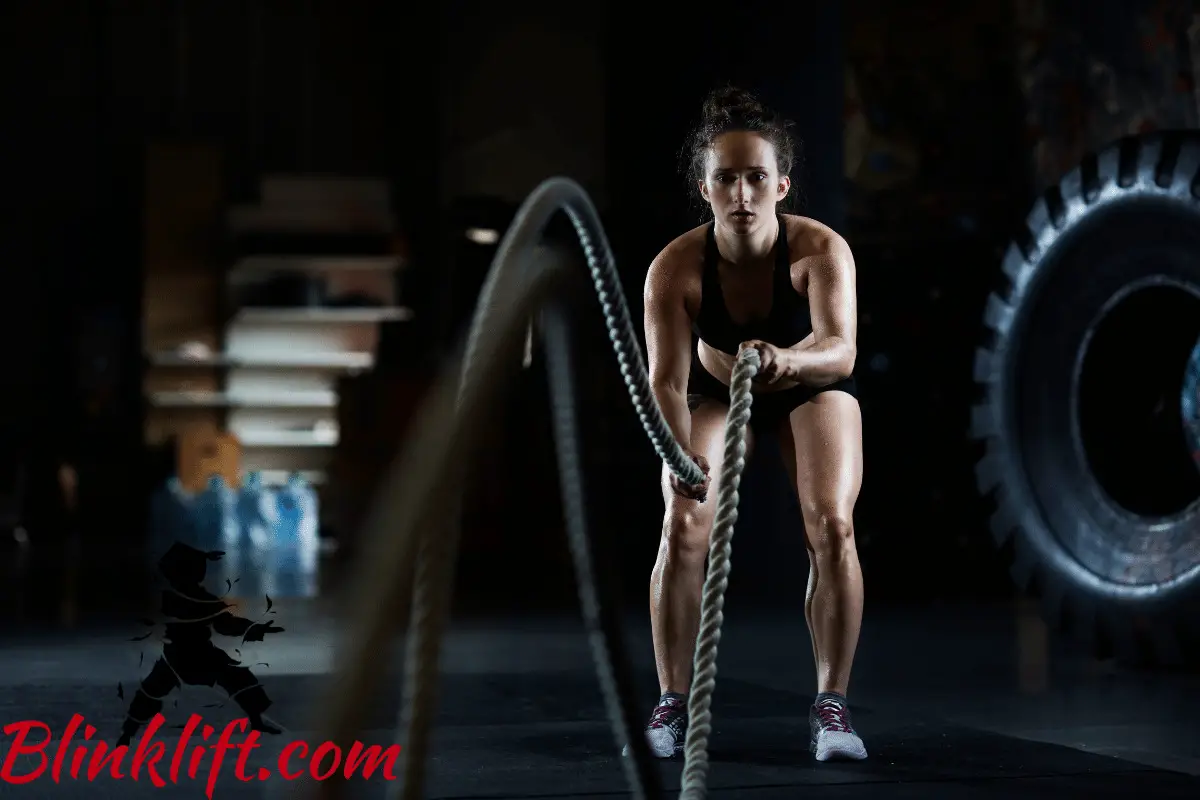Your conditioning level as a Muay Thai fighter is one of the most important attributes you can work on. In fact, many fighters pay no attention to this fact and end up not reaching nearly the level they could reach, which is why I’ve decided to write this article.
I see many Muay Thai fighters with solid technique, who can throw some solid punches and kicks. However, their conditioning and cardiovascular shapes aren’t as high, not allowing them to fight for more than a few minutes.
This article will solve that issue for you. If you’re genuinely serious about your Muay Thai training, the last thing you want to do is only do Muay Thai training. Instead, you want to involve other training methods in your workout regimen, including conditioning and strength workouts.
I’ve already covered the best strength exercises for fighters, which you can read by following the link. Now, it’s time I cover the other side of the coin, which you must incorporate to unleash your fighting abilities and become a fearsome fighter. You’ll take your fighting abilities to heights you never thought were possible before.
I want you to start training already. Without further introduction, here are the best conditioning exercises for Muay Thai!
#1 – Jump Rope
The first exercise we’ll review is the jump rope drill. This has become such a popular drill for fighters not only because it looks good on camera, but because it’s actually useful and effective.
Jumping rope is a classic exercise that enhances footwork, agility, and cardiovascular endurance. It helps in developing quick foot movements, which are crucial in Muay Thai for evading attacks and setting up strikes.
Once you’re comfortable with regular jump ropes, you can make it trickier. You can jump with one foot at a time, you can do a double jump. It’s all a matter of how skilled you are using the jump rope.
What you’ll see happening is that your footwork skills improve the better you get at the jump rope. One of the best footwork drills in Muay Thai is using the jump rope, and that’s for a good reason. You’ll become light on your feet, capable of moving around and surprising your opponents with ease.
It’s also a fantastic drill for improving your cardiovascular health, conditioning you to spars and real fights. So make sure to incorporate the jump rope drill in your weekly training.
If you don’t own one, follow this link to buy the jump rope I currently have and use—all the time.

#2 – Shadowboxing
The second exercise that’ll skyrocket your conditioning is shadowboxing. This is, like the previous one, extremely popular among fighters. And once again, there’s a good reason for that.
Shadowboxing is a fundamental exercise in Muay Thai training. It allows you to work on your technique, footwork, and combinations without a partner. It also helps improve your muscular endurance and coordination.
For the sake of sticking to the subject of this article, when you aim to improve your conditioning, you want to focus on power, speed, and throwing combinations. While you might need to hone your technique at first, it won’t be suitable for conditioning and improving cardiovascular health.
You’ll sweat a whole lot when you shadow box quickly while focusing on combinations and footwork. You want to be moving around and not stay in place. Your goal is to move your body as much as possible while using all your muscle groups. You want to kick, punch, elbow, and knee. Of course, it’ll be best if you already have a solid technique for all the basics. If you don’t, shadowboxing in the way I’m describing will not benefit you as much.
#3 – Running or Sprints
Running and sprints will allow you to improve upon two attributes that all professional Muay Thai fighters have. The first is explosiveness, which sprints improve, and the second is increased stamina duration, which is excellent for withstanding long fights.
Running is an excellent way to build stamina and cardiovascular fitness. Whether you choose steady-state jogging for longer durations or high-intensity sprints for shorter bursts, both can be beneficial for Muay Thai conditioning.
I absolutely love the benefits of running. And I see the same thing with other fighters; they utilize running to improve their aerobic shape, which will help them withstand more rounds.
However, you also want to work on your anaerobic shape, which sprints do well. You can also run at a faster pace and increase your heart rate more to improve both your aerobic and anaerobic shape. These will be shorter runs, of course.
If you’ve never run for Muay Thai conditioning before, I want you to start by running twice a week. Run 3-5 miles each run and amp up the pace when you feel ready. Measure your time, as that’ll give you another incentive to shorten your next run and add a bit of competition into the stakes (you’ll compete with yourself.)
When you feel like you’re ready, start running 3-4 times per week and for longer distances.
#4 – Bag Work
Heavy bag and Thai pads training are essential for developing power, speed, and accuracy in strikes. Incorporate various combinations, kicks, elbows, and knees during bag work to simulate real fight scenarios.
If you want to buy a punching bag for your home so you can train Muay Thai from your home, follow this link to read about Muay Thai’s best punching bags for your home (cost-effective and high-quality!)
To work on your cardiovascular health with heavy bag work, you must throw combinations at the punching bag. If you throw single elbows, you might sweat a little bit but it won’t be enough to promote growth conditioning-wise. Thus, I encourage you to begin practicing the same combinations over and over again.
Because, as Bruce Lee said, “I fear not the man who has practiced 10,000 kicks once, but I fear the man who has practiced one kick 10,000 times.” To take your fighting game to the next level, you want to continuously throw the same combinations until they become second nature to you. This is great both for improving your fighting ability and for conditioning, as you’ll throw them quicker, making it more difficult.
#5 – Circuit Training
Circuit training is a fantastic tool to have in your arsenal. You’ll be able to use it whenever you want to improve your physical shape while working on various muscle groups. It’s not typically used to target the same muscle group, as that’ll leave your muscle overly fatigued, which doesn’t maximize growth.
Create a circuit of different exercises and perform them in a sequence with minimal rest. This form of training enhances both aerobic and anaerobic conditioning, which is crucial for the intense pace of Muay Thai fights.
For instance, you can take the bench press, battle ropes, weighted pull-ups, lateral raises, and the jump rope and perform without resting between sets. This will be much, much harder than your typical, average workout, particularly if it’s strength training.
This will condition you perfectly for a fight, which is what most fighters want to achieve from their training. So make sure to incorporate circuit training at least once a week and be ready to suffer. But remember, suffering is what you’re looking to achieve. The more you suffer and the more physical and mental pain involved, the more progression and growth this exercise will lead to.
Let’s move on to the next one!
#6 – Battle Ropes
Battle ropes are excellent for building shoulder and grip strength, which are essential for clinching and controlling your opponent in Muay Thai. They also provide a great cardiovascular workout.
The battle ropes are also suitable for strength training. If you want to improve your Muay Thai strength, which influences your kicking and punching power, here are the best strength exercises for Muay Thai!
Battle ropes also build your aerobic and anaerobic shape, which are critical for your fighting skills. I like to measure the effectiveness of a certain workout by how much you suffer when doing them. The more you suffer, the more muscle groups you’re likely to use, and the more calories you’re likely to burn.
Likewise, the more growth and improvement you’ll see in your abilities to withstand longer fights and use explosiveness to your advantage.
Incorporate battle ropes at least once per week for a few minutes. Perform sets of them and you’ll see continuous improvement in your conditioning.

#7 – Plyometrics
Plyometric exercises, such as box jumps, lateral jumps, and medicine ball throws, help improve explosive power and fast-twitch muscle fibers. These explosive movements can mimic the explosive nature of Muay Thai techniques.
This is actually very interesting, so I want you to pay close attention now. What I’m trying to give you is the best preparation for your next fight, whether it’s a competitive fight or just a regular spar. We want, from our strength and conditioning exercises as one, to mimic the condition that you will face in a real fight.
This is why battle ropes and jump rope are such good examples of conditioning exercises, particularly for Muay Thai. Jump rope might not be as suitable for other sports, perhaps tennis or basketball (it might be, I don’t have the slightest clue.) However, it’s suitable for Muay Thai because it prepares you for the sport itself.
Plyometrics exercises, like squats, box jumps, and lunges will make you stronger and increase your explosiveness. As a result, you’ll be able to highly benefit from these activities, especially if you emphasize growth and explosiveness.
How to Prepare for a Muay Thai Fight
Preparing for an upcoming Muay Thai fight can seem like a difficult thing to do, especially if it’s your first time. That’s why knowing what to focus on—is critical. This is what we’ll discuss in this section. I’ll go about it briefly, so pay attention.
The best way to prepare for a Muay Thai fight is to gradually increase the stress from your training and make sure you include conditioning, strength, and fighting workouts. You want all three to optimize your training and avoid overtraining, which will stop many fighters from reaching their complete potential.
The first step is to amp up the number of times you do actual Muay Thai per week. You want to eventually have 6-7 training days per week, assuming you’re genuinely serious about the upcoming fight.
Meanwhile, you want to work on your cardiovascular health and condition your body to be able of withstanding many rounds. This is critical to understand. You want to condition your body and not just focus on throwing the most powerful knee, punch, elbow, or kick. Working on all areas of being a fighter will equal optimized progression and skill level.
Final Words
Muay Thai is truly an electrifying world. You will find it difficult, however, to compete in this world without optimizing your weekly training regimen. While you must train in actual Muay Thai to become better at fighting, you also want to incorporate conditioning exercises, such as the ones we’ve reviewed in this article.
What do I recommend you do next? I encourage you, the fighter who has read this article, to incorporate a few of them into your weekly routine. This can be before your Muay Thai training, after it, or on rest days. You want to gradually add on more stress and more pressure, which will prevent injuries. Imaging going from 0 running miles per week to 100. Your body will literally collapse.
So add on training gradually.

